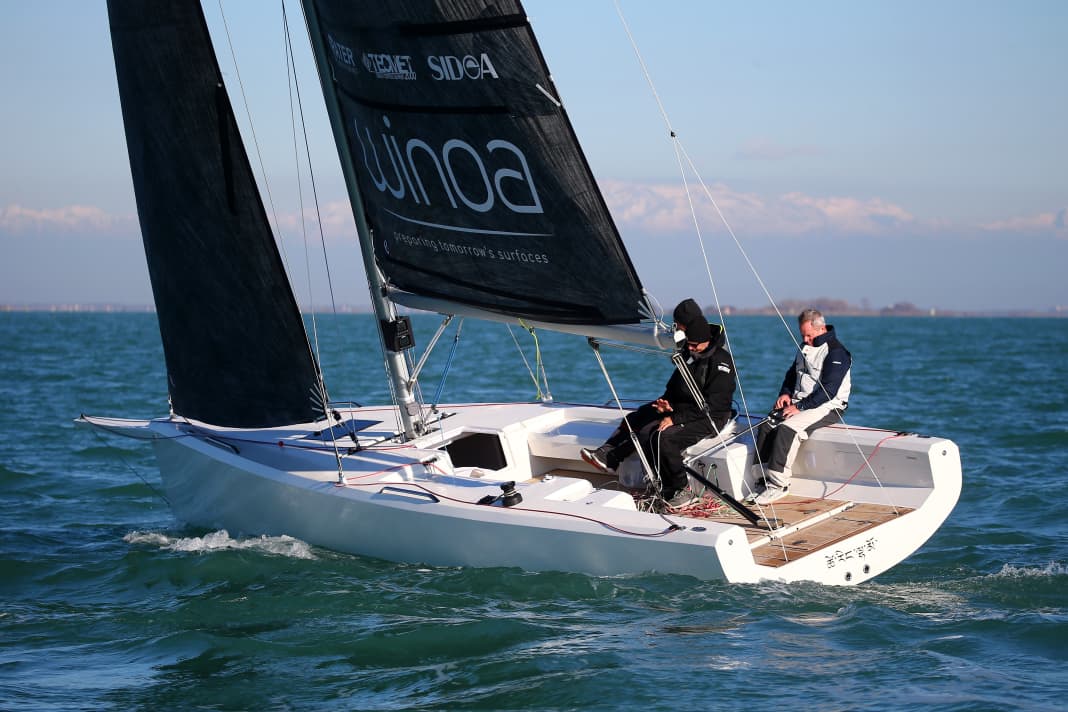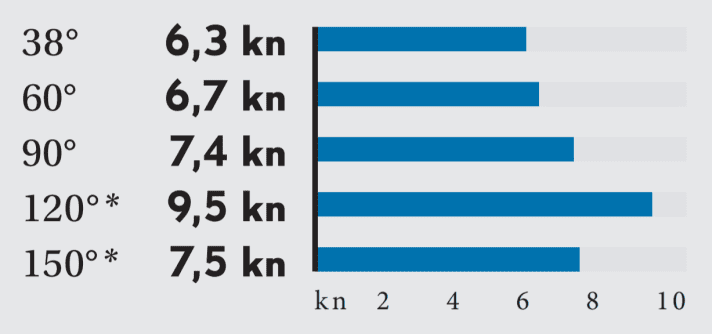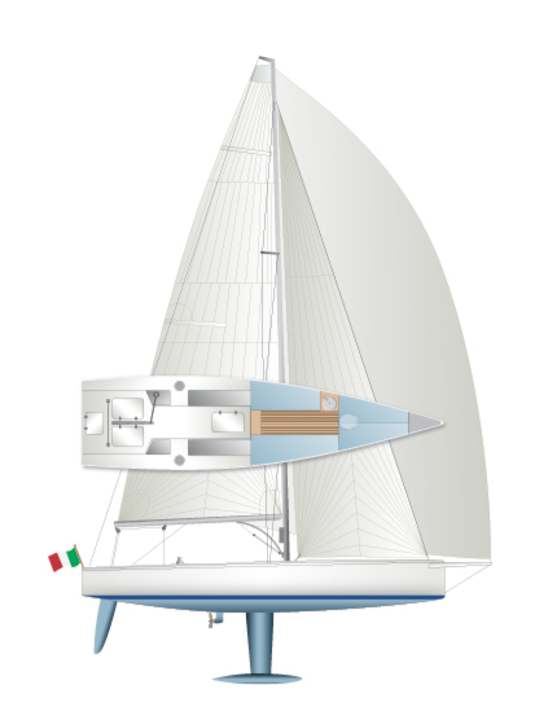





In this article:
A turning angle of 75 degrees is a real statement, even for a slim and powerful regatta boat. During the YACHT test, Alessandro Comuzzi's C-32 drew a remarkable wake in the azure waters of the Gulf of Trieste. In ideal conditions between 12 and 15 knots of wind, the speed over the ground is also just right: the log reports 6.3 knots with less than 40 degrees of altitude to the true wind direction. If the windward speed, i.e. the VMG (velocity made good), is calculated from this performance data using the standard formula, the boat would theoretically be travelling directly into the wind at a net speed of 4.9 knots when cruising. This is very good for a boat with a hull length of less than ten metres.
Designer Alessandro Comuzzi has already attracted attention with a whole series of sporty daysailers and successful regatta yachts. Now the Italian from Udine wants to make a breakthrough with his own brand, Comuzzi Yachts. The first model from the newly established shipyard is the C-32, which is now to go into series production in two versions.
Comuzzi designs three variants
The prototype we tested corresponds to the Sport version. This boat has a regatta-optimised layout for active teamwork. Buyers can largely decide for themselves where the fittings should be positioned and in what quantity and quality. This depends on whether the boat is to be sailed with a self-tacking jib or with an overlapping genoa. In the Sport version, however, the boat does not have a cabin superstructure, but only a very narrow companionway.
The second variant is the weekender, which has not yet been realised in this form. The hull, the hull appendages and the rig remain unchanged, but the deck is supplemented with a short cabin superstructure. And: In this version, all lines are led back below deck to two winches, which can also be reached by the helmsman at the tiller. The Weekender should therefore be suitable for single-handed sailing and equipped with a self-tacking jib as standard.
Alessandro Comuzzi has also developed another version for people with disabilities. The boat is equipped with a huge steering wheel without spokes integrated into the hull, which wheelchair users can easily pass through. For this purpose, the cockpit is cut out at the front and the layout is supplemented with appropriate fittings. The Comuzzi shipyard has already built and delivered a C-32 type boat as the second vessel in the series.
Precise control at the wind edge
Apart from the very good performance data, the extremely slim design with an aspect ratio of 3.9 sails stiffly, sits perfectly on the rudder and can be steered comfortably and precisely on the wind edge with the tiller.
The long T-shaped fixed keel with the torpedo-shaped lead bomb offers a high ballast ratio of 40 per cent of the total weight and is therefore correspondingly efficient. The fin is available in three versions with draughts of 1.80, 2.00 or 2.20 metres. A version with an electro-hydraulic lifting keel (1.40 to 2.00 metres draught) is also feasible. The construction plans for this are already available. In this case, the boat is also equipped with a recoverable cassette rudder. Together with the width of only 2.50 metres, the boat can be transported on a road trailer.
Features of the Comuzzi C-32
The C-32 is supplied as standard with a slim aluminium rig from Licospars with two spreaders. A carbon fibre mast from Pauger Composites is available as an option, but the sail plan remains unchanged. The 1.30 metre long carbon bowsprit is bolted on and can be removed for transport by road, albeit quite awkwardly. A version with a folding bow trunk would be advantageous - also for harbour manoeuvres.
There is plenty of storage space in the stern of the boat under the cockpit floor. The compartments not only have room for all the fenders, but also for the additional sails. The openings are generously cut out for this purpose. Although the lids are lightweight, they are not very sturdy and give way under load. Comuzzi will make these flaps stronger for the series.
The engine is also installed under the cockpit and is easily accessible from the outside. For the series, the Italians have opted for the smallest built-in diesel from Volvo Penta with 13 hp and Saildrive propulsion. An electric drive with corresponding power is available as an alternative.
The hull and deck are built as GRP sandwich constructions using a vacuum infusion process and vinyl ester resin. The floor assembly is manufactured monolithically and is subsequently glued and laminated into the hull. The bulkheads are made of plywood.
Height below deck of the C-32 is tight
Due to the comparatively low freeboard and the lack of a cabin superstructure, space and above all height below deck is limited. Sitting upright on the side sofas is therefore hardly possible in cabin number one; you have to tuck your head in. Lying down and sleeping, on the other hand, is fine. The sofa berth on the starboard side is well over two metres long and also wide enough at the shoulders. On the port side, the berth is slightly shorter due to the built-in sink, but at 1.94 metres it is still long enough to sleep on. Due to the slim construction in the foredeck, it is cramped there with double occupancy. However, one person can rest comfortably.
The fit-out standard below deck on the prototype does not yet meet the expectations of shipyard boss Alessandro Comuzzi. The surfaces are rough and the interior components do not fit together seamlessly in all areas.
The C-32 is an extremely exciting addition to the sporty weekender market. The high performance with winning potential on the regatta course, the variance in equipment and deck design as well as the possibility of transport by road also make the boat particularly versatile. And on top of that, the price is right.
Measured values Comuzzi C-32
Sailing performance, without drift and current

Wind speed: 12-15 kn (4 Bft), wave height: approx. 0.50 m
* with gennaker
Potential STZ* = 5.5

The sail area is only moderately large due to the measurements. On the other hand, the boat is quite light
* Dimensional number. Calculation 2√S/3√V. The higher the value, the more sail area (S) the ship has in relation to the displacement (V)² according to the YACHT definition
YACHT rating
Attractive weekender from Italy with many possible variations. The sailing performance in the test is remarkably good, especially the height upwind. The price is attractive in comparison
Design and concept
- + Customisable cockpit layout
- + High ballast content
- + Variant as inclusion boat
Sailing performance and trim
- + Runs very high
- + Sails stiffly on the wind
Living and finishing quality
- + Limited touring capability
- - Very little height below deck
Equipment and technology
- + Lifting keel as an alternative
- + Large storage compartments in the rear
- - Engine panel below deck
Technical data of the Comuzzi C-32

- CE design category: B/C
- Torso length: 9,70 m
- Total length:10,95 m
- Waterline length: 8,93 m
- Width: 2,50 m
- Draught/alternate..: 2,00/1,80/2,20 m
- Draft/lifting keel: 1,40-2,20 m
- Mast height above WL:14,50 m
- Theor. torso speed: 7.3 kn
- Weight:2,5 t
- Ballast/proportion: 1,0 t/40 %
- Mainsail: 33,5 m²
- Self-tacking jib: 23,0 m²
- Genoa (106 %): 27,0 m²
- machine (Volvo P.):9 kW/13 hp
- Fuel tank: 50 l
- Design: Alessandro Comuzzi
Hull and deck construction
GRP sandwich constructions with foam core and vinyl ester resin, completely constructed using the vacuum infusion process. Monolithic floor assembly glued and laminated in place
Rig
2-salings aluminium rig from Licospars as standard, with Dyform shrouds. A carbon fibre mast from Pauger is available as an option
Sail
Optional furling genoa with 106 % overlap or self-tacking jib. The sails are not yet included in the basic price
Surveying
The tested prototype receives a rating of 596.1 GPH according to ORC. This handicap was calculated for the boat with self-tacking jib and gennaker
Equipment and prices
- Base price ex shipyard € 130,000
- Price ready to sail 2149.185 €
- Warranty/against osmosis 2/2 years
(all prices as at Q2/2023)
Shipyard and distribution
Comuzzi Yachts, 33050 Pozzuolo del Friuli (Italy), www.comuzziyachts.com

